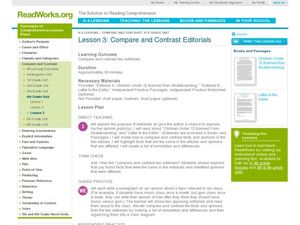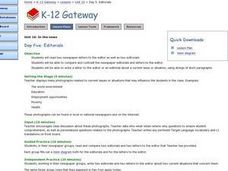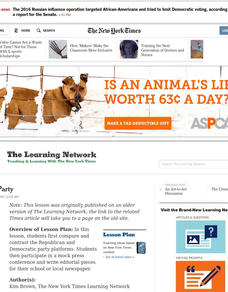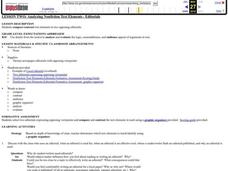Read Works
Compare and Contrast Editorials
Does your class know what an editorial is? Introduce the genre to them with this plan. First, the teacher models how to read an editorial and compare and contrast. Next, the class has a chance to analyze editorials written by their own...
Curated OER
Editorials
Students investigate editorials. In this literacy critical thinking instructional activity, students compare and contrast two newspaper editorials and two letters to the editor by completing a Venn diagram. Students work in groups to...
Curated OER
What is a Family?
Students explore how Canadian families have evolved over time. In this census results lesson, students examine the factors that contribute to changing family and household structures. Students also create written and illustrated profiles...
Curated OER
A Durable Memento: Portraits by Augustus Washington
Students read primary source newspaper articles from mid 19th century United States. The topics of the articles are slavery, abolitionism and colonization. Students are given several options for activities based on the readings.
Curated OER
Reduce, Reuse, Recycle
Students brainstorm and share opinions about products that can be reused or recycled after reading the article, "Seattle's Recycling Success Is Being Measured in Scraps." They then investigate, analyze and evaluate articles on recycling...
Curated OER
Carter as President and Ex-President
Students examine how Presidents are judged during their time in office as well as afterwards. They conduct and Internet search for Jimmy Carter's inaugural address and write a news story about his address. Once they have written an...
Curated OER
Understanding Tibet
Students work in cooperative groups to read one current situation of Tibet. They respond to a set of discussion questions. Pupils write a newspaper article expressing the current information explored. Students write an editorial or...
Curated OER
The Editorial Revisited
Young scholars identify different types of editorials. They explain, using a graphic organizer, the elements that make an editorial powerful. They offer elements they came up with and the examples and list them on the board.
Curated OER
Dear Me
Students take a classroom "gallery walk" memorializing 9/11. As a class, they read and discuss the article "A Day to Clear the View, and Remember." Then, they write letters focusing on events that have made them want to alter their life...
Curated OER
School Newspaper
Fifth graders write a website based school newspaper using a variety of literary forms to present the news of the school.
Curated OER
It's My Party
Students compare/contrast the Republican and Democratic platforms using Venn diagrams, then read and discuss, "The Conventions Are Over. The Party's Just Starting." students then participate in a mock press conference and write editorial...
Curated OER
Separate But Equal Opinions
High schoolers examine the ways in which editorials and Op-Ed pieces respond to current events. They write editorials in response to news items from the New York Times.
Curated OER
Volunteering for Others
Students research the kind of volunteer options for teens in their area, using the Internet and calls to local agencies. Students conduct a simple survey in your school or ask volunteer organizations you contact to help you get in touch...
Curated OER
Critical Thinking & Writing: Brainstorming
Have your young writers organize their thoughts before writing. They generate ideas through various brainstorming activities prior to writing a mock feature news story for USA Today. A series of USA Today articles debating the level of...
Curated OER
Analyzing Nonfiction Text Elements - Editorials
Students examine the text features of non-fiction. In this literacy lesson, students read editorial samples provided by their instructor and analyze the texts for word choice, details, and organization.
Curated OER
Editorials- Facts that Support Opinions
Fourth graders complete a worksheet. In this author's opinion activity, 4th graders read editorials and determine how the use of facts supports the author's opinion. Students complete a facts to support opinions chart.
Curated OER
Propaganda Techniques
Sixth graders locate examples of persuasive writing. In this persuasive writing instructional activity students work in a groups to identify and analyze the use of propaganda techniques. Students use newspapers to find editorials, or...
Curated OER
Editorial Cartoon: Equal Opportunity
learners explore how editorial cartoons often use familiar adages or idioms in new ways to make a point about something.
Curated OER
Learning Types of Editorials - and Writing Some
Students recognize and differentiate between the three types of editorials in order to write editorials for the school newspaper. In this editorials instructional activity, students read example persuasive and interpretative editorials....
Curated OER
Editorial Writing as a Catalyst for Discussion of Important Issues
Young scholars decide which issues are most important to their student body and work in cooperative learning groups to write editorials. In this editorial writing lesson, students brainstorm a list of the most important issues and bring...
Curated OER
Editorial Writing: What's On Your Mind
Students write an editorial column for a newspaper. For this journalism lesson, students discuss and analyze editorials in print and broadcast media. Students will compare the differences in these two formats of editorial pieces and then...
Curated OER
Science TV: Making it Real
High schoolers explore the ways science is presented in a children's television show. Students conduct internet research, and then create and design a skit that highlights the problem-solving process.
Curated OER
What's in a Newspaper
In this what's in a newspaper worksheet, students analyze different aspects of a newspaper. Students give the title and reason why ads, news, features, and editorials are in the paper.
Curated OER
Journal Assignment Directions
In this journalism analysis learning exercise, students choose and editorial article and analyze the content. Students will write articles with a minimum of 350 words.

























